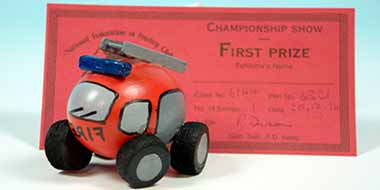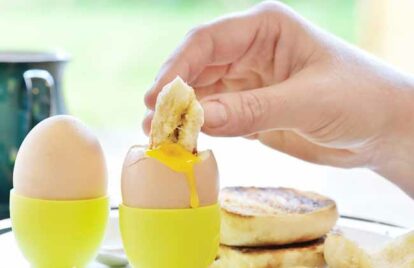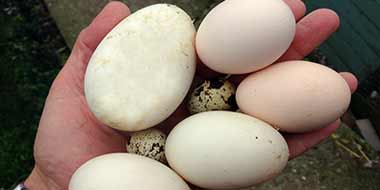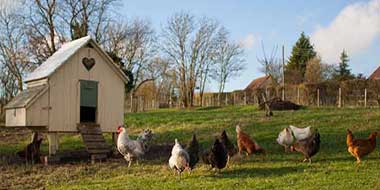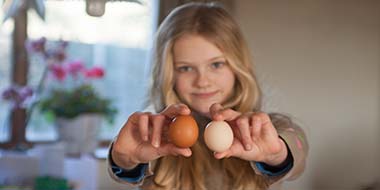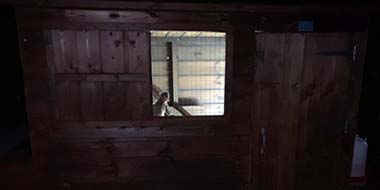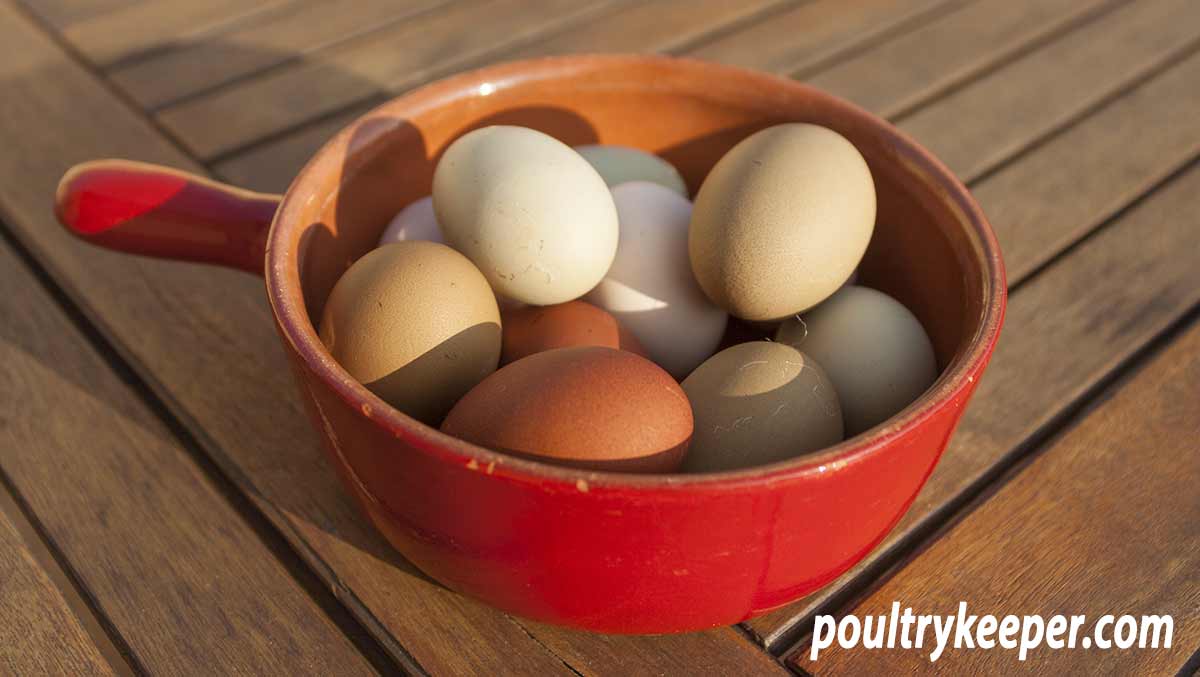
Have you ever wondered what colour eggshells are possible? Or what actually causes them to be a different colour? In this article, Gail explains chicken eggshell colour and lists chicken breeds and the colour of their eggs.
The default colour of an eggshell is white. Chicken eggshell colours are influenced by at least eight known genes that control two types of pigment, one for brown and one for blue. All hens have the genetic potential to produce these pigments. We see a vast range of eggshell colours because some hens use both types of pigment, some use varying amounts of one or the other, and some use none.
White eggshells
A chicken’s eggshells are made primarily of calcium carbonate, which is white. Eggshells that lack pigment are therefore plain white.
Eggs with white shells are commercially preferred in many countries. From the consumer’s traditional point of view in purchasing groceries, an egg with a white shell appears clean and pure. From the producer’s point of view, eggs with white shells are easier to candle for blood spots, shell cracks, and other defects prior to being packaged for sale.
A correlation between shell whiteness and natural antibodies (which confer resistance to disease) was discovered by Dutch researchers. The research team determined eggshell whiteness by averaging the colour of each hen’s first three eggs laid. Chicks that hatched from eggs laid by Leghorn hens with the whitest shells had the highest level of natural antibodies. This relationship between chicken eggshells and immunity is now under investigation.
Brown eggshells
The brown colour of an eggshell comes from the pigment protoporphyrin derived from haemoglobin in the blood. Protoporphyrin produces reddish-brown colours.
Most of this pigment occurs on the surface of the shell, beneath the bloom (aka cuticle). Cleaning an egg with a brown shell will sometimes dissolve or rub off some of the brown colour. While the inside of the shell remains white, the outside of a brown eggshell can range in shade from barely tinted to nearly black.
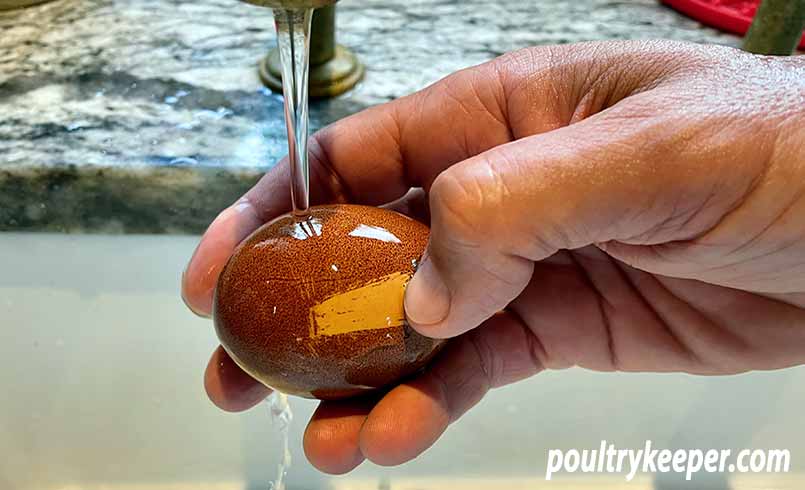
The eggs of a brown-egg layer generally get paler as the laying cycle progresses but will become darker when the new laying cycle starts. It’s as if a hen needs time off to renew her supply of pigment.
Brown shells get lighter also as a hen ages and lays progressively larger eggs. That makes sense because the same amount of pigment must spread over a larger surface.
Viral diseases that infect the reproductive system can cause a brown-egg laying hen to produce paler shells. Internal parasites can affect shell colour by interfering with the absorption of nutrients necessary for egg production. Certain drugs, including coccidiostats, also can cause brown shells to be paler or even white.
Stress can make brown-shell hens lay eggs that are a lighter shade than usual. Overcrowded nests, rough handling, loud noises, and anything that makes hens nervous or fearful can cause them to lay prematurely before the brown-bloom coating is completed.
On the other hand, a stressed hen may instead retain the egg long enough to add an extra thin layer of white shell on top of the bloom, causing the colour to be lighter than usual. Brown-shell eggs that inexplicably become lighter may be an indication something is bothering the hens.
Blue eggshells
A blue eggshell gets its colour from the pigment biliverdin, which results from bile formation. Biliverdin produces shades of blue and green. Unlike brown pigment on the shell’s surface, blue pigment mixes with the calcium carbonate and therefore occurs throughout the shell. The shell is blue on the inside, as well as on the outside.
Blue shell colour is a dominant trait. It occurs because, at some point in history, a harmless retrovirus (endogenous avian retrovirus) inserted itself into the chickens’ DNA, allowing the expression of an existing gene for blue shells.
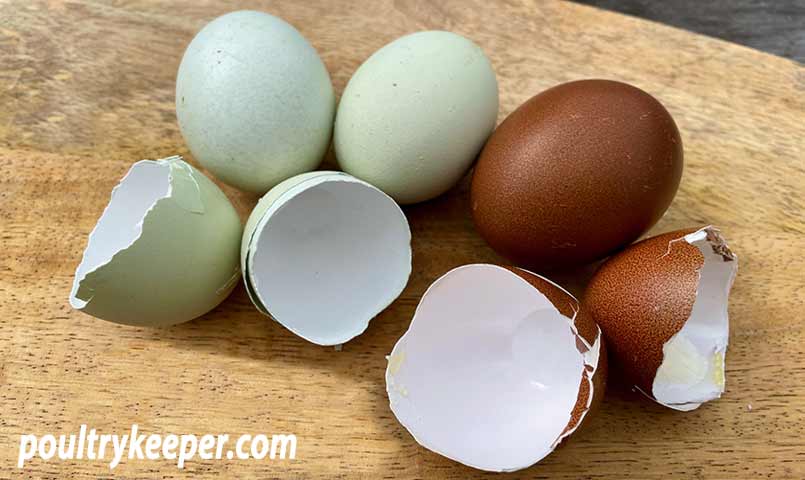
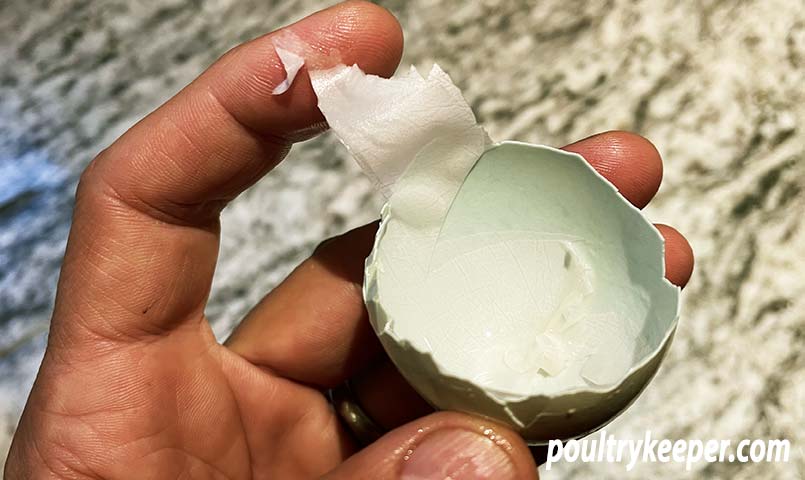
Green eggshells
An egg with a green shell is the result of a cross between a blue-egg breed and a brown-egg breed, yielding blue eggshells with a brown coating. A dark brown pigment laid over a blue egg results in an olive coloured shell.
Crossbreeding simplified:
Blue X Blue = Blue
Blue X White = Pale Blue
Blue X Brown = Green
Blue X Dark Brown = Olive
Bloom and shell colour
The bloom is the last thing to coat an eggshell before the egg is laid. Some hens produce a thicker layer of bloom than others. The thickness of the bloom can affect an eggshell’s apparent colour.
For instance, a pale brown shell with a thick bloom may appear pinkish. A dark brown shell with a thick bloom may look purple. An olive shell with a thick bloom may appear grey.
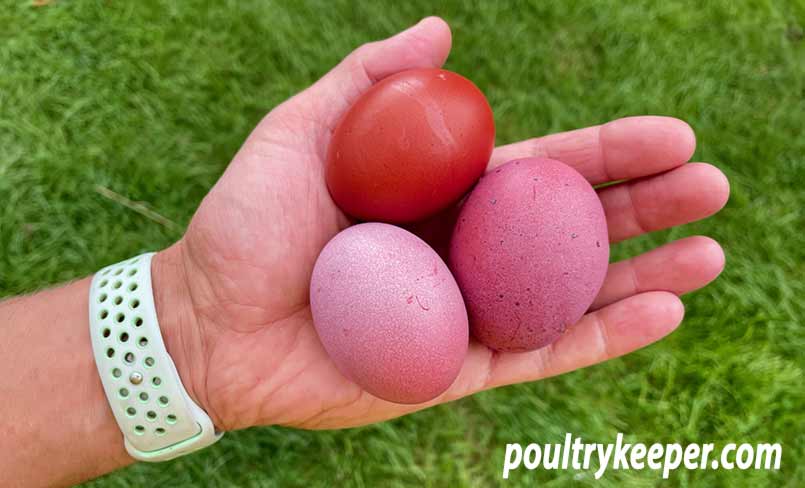
Earlobes and chicken eggshell colours
Colour variations occur within each breed or strain, although all the eggs laid by a single hen have the same basic shell colour. Since the colour is governed by genetics, if a breeder is not specifically selected for shell colour, future generations may produce eggs with shell colours that differ from those of the original hen(s).
In a general way, chicken eggshell colour correlates with the colour of a hen’s earlobes. Most hens with white earlobes lay eggs with white shells. Hens with red earlobes lay eggs with brown shells.
Like every rule, this one has exceptions. For instance, Crevecoeur, Dorking, and Redcap have red earlobes but lay eggs with white shells. Araucanas and Ameraucanas have red earlobes but lay eggs with blue shells. Legbars, too, lay blue-shell eggs but have white earlobes. Penedesenca and Empordanesa have white earlobes but produce among the darkest brown shells of any breed.
Other breeds don’t fit the earlobe rule by laying white or lightly tinted eggs that don’t correlate with their earlobe colour. Sebrights and Sumatras have purplish earlobes. Silkies and some Sebrights have turquoise earlobes.
Chicken eggshell colour chart
The following chicken eggshell colour chart covers British and American chicken breeds.
Breeds A-K
| Breed | Shell Colour |
| Ameraucana | Blue |
| American Game Bantam | Tinted |
| Ancona | Tinted |
| Andalusian | Chalk White |
| Araucana | Blue |
| Aseel | Tinted |
| Australorp | Brown |
| Ayam Cemani | Creamy White |
| Barnevelder | Dark Brown |
| Belgium Bantams | White |
| Booted Bantam | White |
| Brabanter | White |
| Brahma | Brown |
| Buckeye | Brown |
| California Grey | White |
| Campine | Tinted |
| Catalana | Tinted |
| Chantecler | Brown |
| Cochin | Brown |
| Cornish/Indian Game | Tinted |
| Crevecoeur | White |
| Cubalaya | Tinted |
| Delaware | Brown |
| Dominique | Brown |
| Dorking | Tinted |
| Dutch Bantam | Light Brown |
| Empordanesa | Brown |
| Faverolles | Light Brown |
| Fayoumi | Tinted |
| Frizzle | Brown |
| Hamburg | Tinted |
| Hedemora | Light Brown |
| Holland | White |
| Houdan | White |
| Icelandic | White, tinted, beige |
| Iowa Blue | Tinted |
| Japanese Bantam | Brown |
| Java | Brown |
| Jersey Giant | Brown |
| Krasienkoppe | Tinted |
Breeds L-Z
| Breed | Shell Colour |
| La Fleche | White |
| Lakenvelder | Tinted |
| Langshan | Dark brown |
| Leghorn | White |
| Madagascar Game | Cream, brown |
| Malay | Brown |
| Marans | Dark brown |
| Minorca | White |
| Modern Game | Tinted |
| Naked Neck | Brown |
| Nankin | Tinted |
| New Hampshire | Brown |
| Norwegian Jaerhon | White |
| Old English Game | Tinted |
| Orloff | Tinted |
| Orpington | Brown |
| Penedesenca | Dark brown |
| Phoenix | Tinted |
| Plymouth Rock | Brown |
| Polish (US)/Poland (UK) | White |
| Pyncheon | Tinted |
| Redcap | White |
| Rhode Island Red | Brown |
| Rhode Island White | Brown |
| Rosecomb | Tinted |
| Saipan Jungle Fowl | Brown |
| Sebright | Tinted |
| Serama | Brown |
| Shamo | White |
| Sicilian Buttercup | White |
| Silkie | White |
| Spanish | Chalk white |
| Spitzhauben (Appenzeller) | White |
| Sultan | White |
| Sumatra | Tinted |
| Sussex | Light brown |
| Svart Hona Svarthöna | Cream |
| Vorwerk | Tinted |
| Welsumer | Dark brown |
| Wyandotte | Brown |
| Yokohama | White |
Chicken Breeds Pages
If you are interested in keeping pure breeds, the Chicken Breeds page has photographs of all 93 standardised British chicken breeds with many breed profile pages.
Shell colour and nutrition
A lot of people erroneously believe that eggs with coloured shells are more nutritious than eggs with white shells. Nutritional value is influenced, not by chicken eggshell colour, but by what the hen is fed. Eggs from free-range hens have been found to be more nutritious than commercially produced eggs from confined hens, regardless of their shell colour.
You can learn more about the egg in this article- About Eggs: A Guide to the inside of an Egg.


